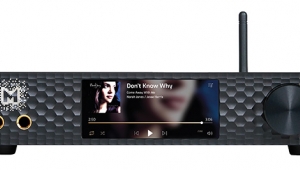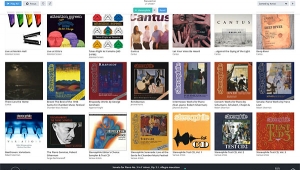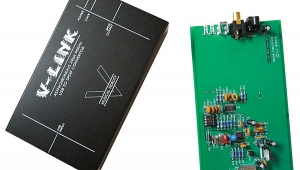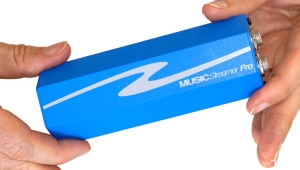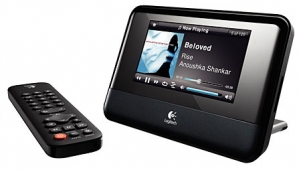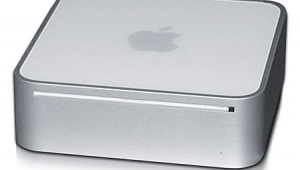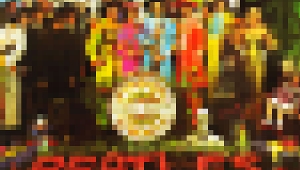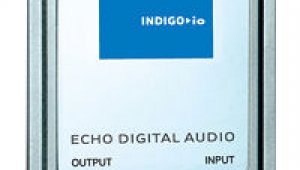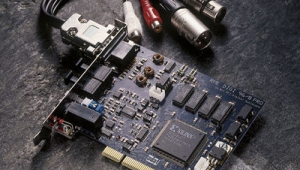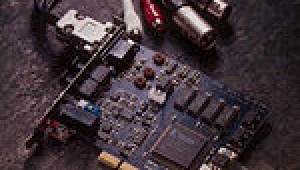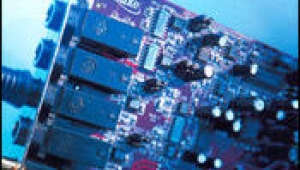| Columns Retired Columns & Blogs |
Echo Indigo IO CardBus soundcard Measurements
Sidebar 3: Measurements
All the tests were performed with the Echo Indigo IO soundcard installed in my 867MHz Apple TiBook. Looking first at the Indigo IO's analog output, using WAV files played back with Bias Peak 4.0, the maximum output at 1kHz with the volume control at its maximum was to specification at 1.603V. The output preserved absolute polarity—ie, was noninverting—and the source impedance was less than 1 ohm across the audioband.
The frequency response was absolutely flat with CD data (not shown). Driving the card with data sampled at 96kHz gave the response shown in fig.1; the output is down 1.5dB at 46kHz, suggesting an antialiasing filter that is well-behaved in the time domain. Channel separation was superb, at better than 100dB between 100Hz and 8kHz, decreasing to 80dB/88dB L/R at 10Hz and 93dB at 20kHz (not shown).

Fig.1 Echo Indigo IO, frequency response at -12dBFS into 100k ohms, with 96kHz sample rate (right channel dashed, 0.5dB/vertical div.).
Commendably for its price, the Indigo IO's DAC offers better than 16-bit resolution. This is shown graphically in fig.2, which shows the spectrum of the card's output, derived with a swept 1/3-octave bandpass filter, while it decoded 16- and 24-bit data representing a dithered 1kHz sinewave at -90dBFS. Both spectra are commendably free from distortion and power-supply-related spuriae, and the increase in bit depth gives an increase in dynamic range of 10-12dB, suggesting DAC performance of around 18 bits. The noise floor rises in level above the mid-treble, due to the noiseshaping used in the DAC chip to get sufficient resolution. Fig.3, taken with 16-bit "digital black" data, shows that the noise continues to rise above the audioband, peaking at around 100kHz.

Fig.2 Echo Indigo IO, 1/3-octave spectrum of dithered 1kHz tone at -90dBFS, with noise and spuriae, 16-bit data (top), 24-bit data (bottom). (Right channel dashed.)
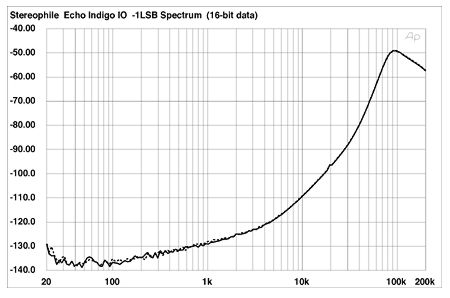
Fig.3 Echo Indigo IO, 1/3-octave spectrum of "digital black," with noise and spuriae, 16-bit data (right channel dashed).
DAC linearity error, assessed with dithered 16-bit data, was less than ±2dB, down almost to -110dBFS (fig.4). In fact, most of the error seen in this graph is due to the dither noise used to encode the signal. As a result of the excellent linearity and the low DAC noise, the Indigo IO's reproduction of an undithered 16-bit/1kHz sinewave at -90.31dBFS was essentially perfect (fig.5), with the three discrete voltage levels unambiguously obvious. Increasing the word length to 24 bits gave a pretty good facsimile of a sinewave (fig.6).

Fig.4 Echo Indigo IO, left-channel departure from linearity, 16-bit data (2dB/vertical div.).

Fig.5 Echo Indigo IO, waveform of undithered 1kHz sinewave at -90.31dBFS, 16-bit data.

Fig.6 Echo Indigo IO, waveform of undithered 1kHz sinewave at -90.31dBFS, 24-bit data.
The soundcard's output stage is impressively low in distortion, a 0dBFS sinewave being reproduced with just 0.0011% distortion (true sum of the harmonics). The spectrum of this distortion is shown in fig.7; not only is it very low in level, it is all subjectively innocuous low-order harmonics. Reducing the signal level to -90dBFS dropped all the harmonics into the noise floor (fig.8), this FFT-derived spectrum correlating with the 1/3-octave spectrum shown in fig.2. (The flat noise floor in this graph is due to its having equal energy per unit of frequency and being plotted on a linear horizontal axis.) Intermodulation distortion was also vanishingly low (fig.9), with the 1kHz difference product from an equal mix of 19kHz and 20kHz tones lying at just -107dB (0.0004%).

Fig.7 Echo Indigo IO, spectrum of 1kHz sinewave, DC-1kHz, at 0dBFS into 8k ohms (linear frequency scale).

Fig.8 Echo Indigo IO, spectrum of dithered 1kHz sinewave, DC-1kHz, at -90dBFS into 8k ohms (linear frequency scale).

Fig.9 Echo Indigo IO, HF intermodulation spectrum, DC-25kHz, 19+20kHz at 0dBFS into 8k ohms, CD data (linear frequency scale).
Despite the laptop's master clock being of unknown quality, the Indigo IO did very well when I checked its immunity to word-clock jitter by using the Miller Audio Research Analyzer to look for jitter artifacts in the IO's output. When I used the analytical signal developed by the late Julian Dunn, the measured jitter level was just 183 picoseconds peak-peak, most of that figure coming from a pair of sidebands at ±15Hz (fig.10, purple "1" markers). Data-related jitter (red numeric markers) was at the residual level of the harmonics in the test signal.

Fig.10 Echo Indigo IO, high-resolution jitter spectrum of analog output signal (11.025kHz at -6dBFS sampled at 44.1kHz with LSB toggled at 229Hz). Center frequency of trace, 11.025kHz; frequency range, ±3.5kHz.
Turning to the Indigo IO's analog inputs, 0dBFS was equivalent to an input level of 1.775V, exactly as specified. The input impedance was also to spec, at 10k ohms at 1kHz. Examined in the digital domain, the IO's ADC linearity error reached +2dB at -90dBFS, implying dynamic range around the 16-bit level (fig.11).

Fig.11 Echo Indigo IO ADC, departure from linearity, 24-bit data (2dB/vertical div., right channel dashed).
As with its DAC, the ADC chip used by the Indigo IO offered very low distortion. With a 1kHz tone at 1.6V RMS, equivalent to -1dBFS, the highest-level harmonic was the second, at -100dB, though there was a slight rise in low-frequency noise once the input signal got within a couple of dB of 0dBFS (fig.12). And when the signal level dropped to 0.875V (-6dBFS, fig.13), even the second harmonic lay at almost -120dB!
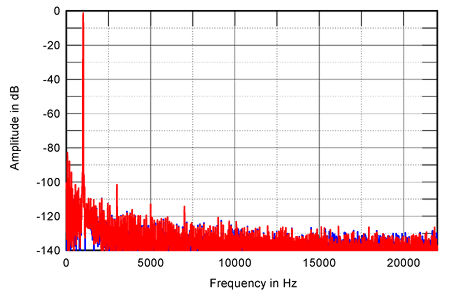
Fig.12 Echo Indigo IO ADC, digital-domain spectrum of 1kHz at -1dBFS, 24-bit data.
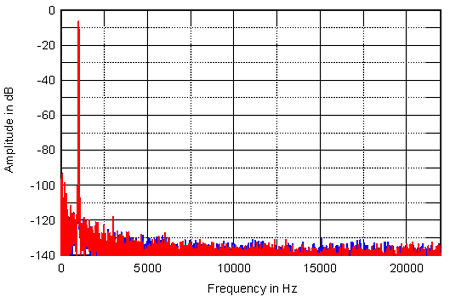
Fig.13 Echo Indigo IO ADC, digital-domain spectrum of 1kHz at -6dBFS, 24-bit data.
Dropping the input level to -70dBFS resulted in there being no harmonics visible above the noise floor (fig.14), while an input equivalent to -120dBFS still resulted in an identifiable signal component in the resultant spectrum (fig.15). However, this is at the limit of the ADC chip's resolving power. Fig.16 shows the digital-domain waveform of an input tone at -115dBFS—eyeballing the shape of the wave through the high-frequency noise suggests that there are just three voltage levels active at this level, which in turn suggests an ultimate resolution of around 18 bits.

Fig.14 Echo Indigo IO ADC, digital-domain spectrum of 1kHz at -70dBFS, 24-bit data.

Fig.15 Echo Indigo IO, digital-domain spectrum of 1kHz at -120dBFS, 24-bit data.
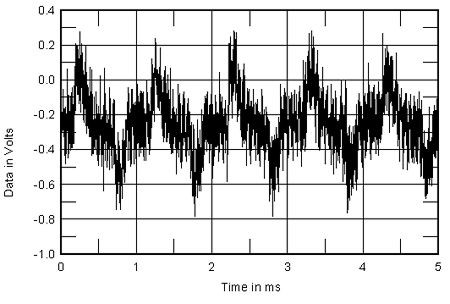
Fig.16 Echo Indigo IO, digital-domain waveform of 1kHz at -115dBFS, 24-bit data.
Considering its low price and the fact that it depends on the host laptop for its power, Echo's Indigo IO offers extraordinarily good measured performance.—John Atkinson
- Log in or register to post comments
